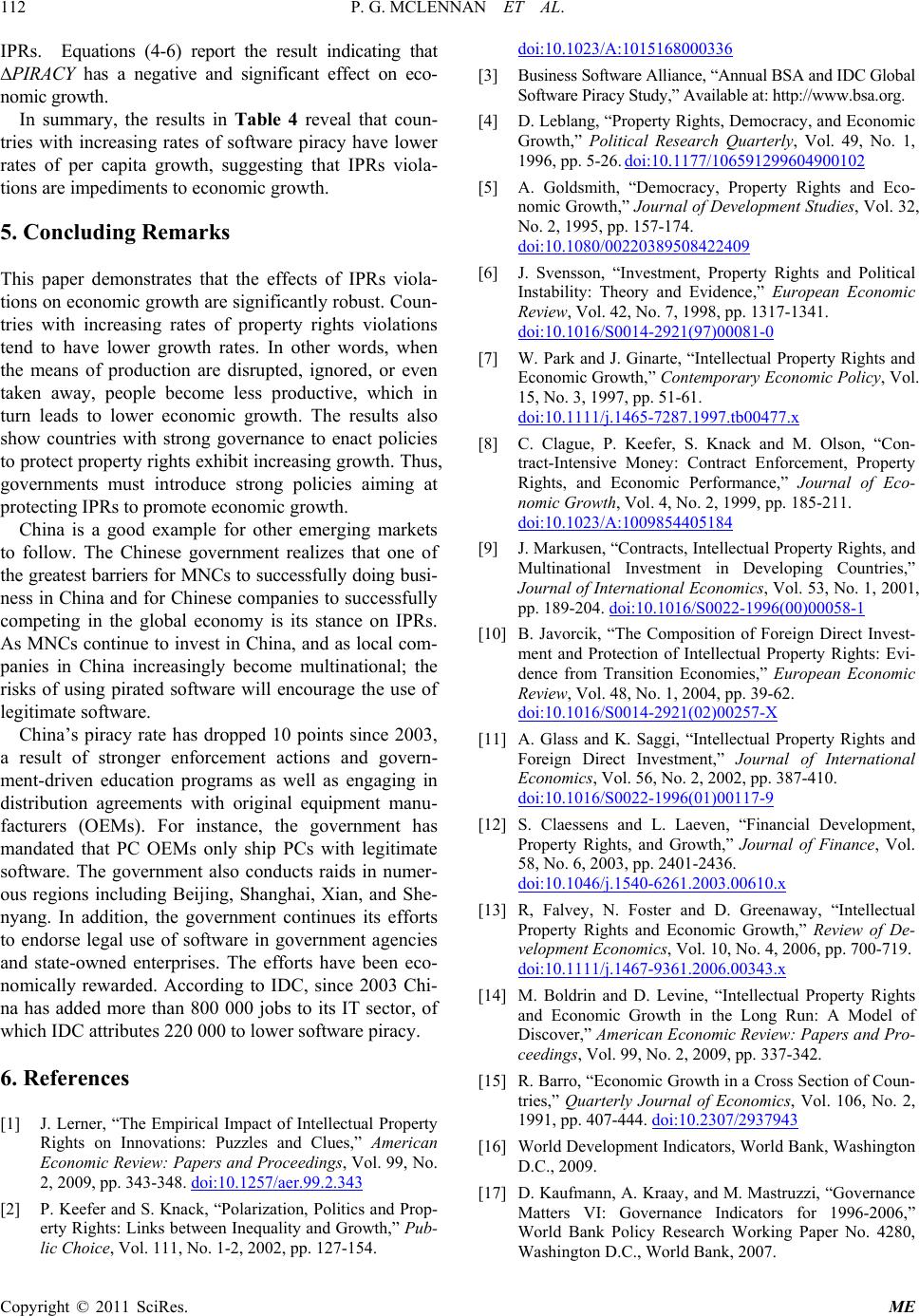
P. G. MCLENNAN ET AL.
Copyright © 2011 SciRes. ME
IPRs. Equations (4-6) report the result indicating that
∆PIRACY has a negative and significant effect on eco-
nomic growt h.
In summary, the results in Table 4 reveal that coun-
tries with increasing rates of software piracy have lower
rates of per capita growth, suggesting that IPRs viola-
tions are impediments to economic growth.
5. Concluding Remarks
This paper demonstrates that the effects of IPRs viola-
tions on economic growth are significantly robust. Coun-
tries with increasing rates of property rights violations
tend to have lower growth rates. In other words, when
the means of production are disrupted, ignored, or even
taken away, people become less productive, which in
turn leads to lower economic growth. The results also
show countries with strong governance to enact policies
to protect property rig hts exhibit increasing growth. Thus,
governments must introduce strong policies aiming at
protecting IPRs to promote economic growth.
China is a good example for other emerging markets
to follow. The Chinese government realizes that one of
the greatest barriers for MNCs to successfully doing busi-
ness in China and for Chinese companies to successfully
competing in the global economy is its stance on IPRs.
As MNCs continue to invest in China, and as local com-
panies in China increasingly become multinational; the
risks of using pirated software will encourage the use of
legitimate software.
China’s piracy rate has dropped 10 points since 2003,
a result of stronger enforcement actions and govern-
ment-driven education programs as well as engaging in
distribution agreements with original equipment manu-
facturers (OEMs). For instance, the government has
mandated that PC OEMs only ship PCs with legitimate
software. The government also conducts raids in numer-
ous regions including Beijing, Shanghai, Xian, and She-
nyang. In addition, the government continues its efforts
to endorse legal use of software in government agencies
and state-owned enterprises. The efforts have been eco-
nomically rewarded. According to IDC, since 2003 Chi-
na has added more than 800 000 jobs to its IT sector, of
which IDC attributes 220 000 to lower software piracy.
6. References
[1] J. Lerner, “The Empirical Impact of Intellectual Property
Rights on Innovations: Puzzles and Clues,” American
Economic Review: Papers and Proceedings, Vol. 99, No.
2, 2009, pp. 343-348. doi:10.1257/aer.99.2.343
[2] P. Keefer and S. Knack, “Polarization, Politics and Prop-
erty Rights: Links between Inequality and Growth,” Pub-
lic Choice, Vol. 111, No. 1-2, 2002, pp. 127-154.
doi:10.1023/A:1015168000336
[3] Business Software Alli a nce , “Annual BSA and IDC Global
Software Piracy Study,” Available at: http://www.bsa.org.
[4] D. Leblang, “Property Rights, Democracy, and Economic
Growth,” Political Research Quarterly, Vol. 49, No. 1,
1996, pp. 5-26. doi:10.1177/106591299604900102
[5] A. Goldsmith, “Democracy, Property Rights and Eco-
nomic Growth,” Journal of Development Studies, Vol. 32,
No. 2, 1995, pp. 157-174.
doi:10.1080/00220389508422409
[6] J. Svensson, “Investment, Property Rights and Political
Instability: Theory and Evidence,” European Economic
Review, Vol. 42, No. 7, 1998, pp. 1317-1341.
doi:10.1016/S0014-2921(97)00081-0
[7] W. Park and J. Ginarte, “Intellectual Property Rights and
Economic Growth,” Contemporary Economic Policy, Vol.
15, No. 3, 1997, pp. 51-61.
doi:10.1111/j.1465-7287.1997.tb00477.x
[8] C. Clague, P. Keefer, S. Knack and M. Olson, “Con-
tract-Inte nsive Money: Contract Enforcement, Property
Rights, and Economic Performance,” Journal of Eco-
nomic Growth, Vol. 4, No. 2, 1999, pp. 185-211.
doi:10.1023/A:1009854405184
[9] J. Markusen, “Contracts, Intellectual Property Rights, and
Multinational Investment in Developing Countries,”
Journal of International Economics, Vol. 53, No. 1, 2001,
pp. 189-204. doi:10.1016/S0022-1996(00)00058-1
[10] B. Javorcik, “The Composition of Foreign Direct Invest-
ment and Protection of Intellectual Property Rights: Evi-
dence from Transition Economies,” European Economic
Review, Vol. 48, No. 1, 2004, pp. 39-62.
doi:10.1016/S0014-2921(02)00257-X
[11] A. Glass and K. Saggi, “Intellectual Property Rights and
Foreign Direct Investment,” Journal of International
Economics, Vol. 56, No. 2, 2002, pp. 387-410.
doi:10.1016/S0022-1996(01)00117-9
[12] S. Claessens and L. Laeven, “Financial Development,
Property Rights, and Growth,” Journal of Finance, Vol.
58, No. 6, 2003, pp. 2401-2436.
doi:10.1046/j.1540-6261.2003.00610.x
[13] R, Falvey, N. Foster and D. Greenaway, “Intellectual
Property Rights and Economic Growth,” Review of De-
velopment Economics, Vol. 10, No. 4, 2006, pp. 700-719.
doi:10.1111/j.1467-9361.2006.00343.x
[14] M. Boldrin and D. Levine, “Intellectual Property Rights
and Economic Growth in the Long Run: A Model of
Discover,” American Economic Review: Papers and Pro-
ceedings, Vol. 99, No. 2, 2009, pp. 337-342.
[15] R. Barro, “Economic Growth in a Cross Section of Coun-
tries,” Quarterly Journal of Economics, Vol. 106, No. 2,
1991, pp. 407-444. doi:10.2307/2937943
[16] World Development Indicators, World Bank, Washington
D.C., 2009.
[17] D. Kaufmann, A. Kraay, and M. Mastruzzi, “Governance
Matters VI: Governance Indicators for 1996-2006,”
World Bank Policy Research Working Paper No. 4280,
Washington D.C., World Bank, 2007.